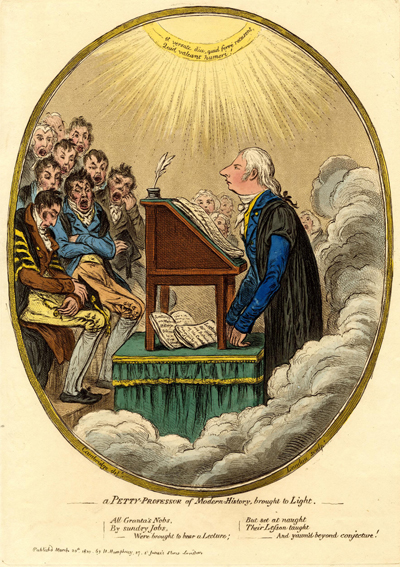A Petty Professor of Modern History, Brought to Light
This is one of four prints relating to Cambridge University created by an amateur and etched by Gillray in the last two years of his productive life. The others include:
- Cambridge Commencement Sermon
- Bristol Cheese, Made & Sold by Percival & Co_
- Matins at D-wn-ng College
Stylistic similarities among the prints, as well as the common Cambridge focus, make it likely that the same amateur was responsible for all four.

[March 20, 1810]
© Trustees of the British Museum
This late and crudely simplistic print is an attack upon William Smyth, the longtime tutor of Tom Sheridan, son of the playwright and Whig leader Richard Brinsley Sheridan. After Tom decided to enter the army in 1806, Smyth left his position to become a Tutor at Peterhouse, the oldest of the Cambridge colleges. Then in 1807, he was appointed Regius Professor of Modern History at the recommendation of another prominent Whig, Lord Henry Petty, Chancellor of the Exchequer in the Ministry of All the Talents. Hence a "Petty Professor." Smyth is pictured here (most likely) delivering his inaugural lecture as Regius Professor to students, fellows, and alumni invited for the occasion.
According to Regius Professor Richard J. Evans in his own inaugural lecture, the Regius Professorship of Modern History (before Smyth) was essentially a sinecure, a political reward, having little or nothing to do with actual qualifications. And that is certainly the thrust of Gillray's satire. Two open "books" appear on the table beneath the lectern suggesting that Smyth's presence at the podium is solely owing to his political connections. One is "Dedicated to Tom Sheridan" the other indicates that it was "Patronised by the Marq. of Lansdowne" (i.e. Petty).
The members of the audience commandeered for this performance ("by sundry jobs... brought to hear a lecture") as Gillray portrays them, are distinctly unimpressed. Most of them are yawning broadly; one has fallen asleep while checking his watch. The Latin verses bringing light to the scene are from Horace's Art of Poetry, and convey what is intended as belated advice for Smyth. For clarity's sake, I include the surrounding context of Gillray's quotation (in bold italics).
Take a subject, ye writers, equal to your strength. Ponder long what your shoulders refuse, and what they are able to bear. Whoever shall choose a theme within his range, neither speech will fail him, nor clearness of order.
As the state of his audience illustrates, Smyth has obviously failed to heed this advice, and the emphasis in Gillray's selection upon what the shoulders of this this "petty Professor"can bear may be intended to highlight the inappropriateness of Smyth's assumption of the academic mantle over the fashionable clothes of a gentleman.
The print was almost certainly based upon a sketch by an amateur which Gillray etched. The production line (in the gold frame) says: "Cambridge delt London sculpt." The figure of Smyth is particularly flat and awkward; the clouds billowing up from his feet are absurd. Even Gillray's etching reveals an unsteady hand, particularly in the inscriptions on the books beneath the lectern, which were typically etched last.
The publication line indicates a date of March 20, 1810—also in an unsteady hand. But it's hard to believe that the print was created then. Smyth was appointed Regius Professor in 1807. Petty was out of office by March of that year. By 1810, all of this was very old news. So the most likely creation date was sometime between January and March, 1807. But, according to Draper Hill,
Gillray's capacity for creative work began to fail in 1807. He evidently had difficulty in completing one plate. At least two others were abandoned. . . . During the late Spring or early summer, he appears to have suffered a mental and physical breakdown, severe enough for him to need a period of recuperation. (p. 143)
Hill does not mention A Petty Professor as one of the affected plates, perhaps because it was NOT ultimately abandoned. But I think it is almost certain that it was being worked on by Gillray in 1807, but postponed by his breakdown and only completed in 1810. The inscriptions on the books and the etching of the publication line would probably have done at the same time in 1810.
Sources and Reading
- Commentary from the British Museum on A Petty Professor of Modern History, Brought to Light.
- Draper Hill, Mr. Gillray The Caricaturist, 1965, 143.
- "William Smyth (historian)," Wikipedia
- "Thomas Sheridan (soldier)," Wikipedia
- "Henry Petty-Fitzmaurice, 3rd Marquess of Lansdowne," Wikipedia
- "Regius Professor of History (Cambridge)," Wikipedia
- Richard J. Evans: Inaugural Lecture
- Thomas Wright and R.H. Evans, Historical and Descriptive Account of the Caricatures of James Gillray #574.
- Thomas Wright and Joseph Grego, The Works of James Gillray, the Caricaturist; With the History of His Life and Times, p. 370.
Comments & Corrections
NOTE: Comments and/or corrections are always appreciated. To make that easier, I have included a form below that you can use. I promise never to share any of the info provided without your express permission.